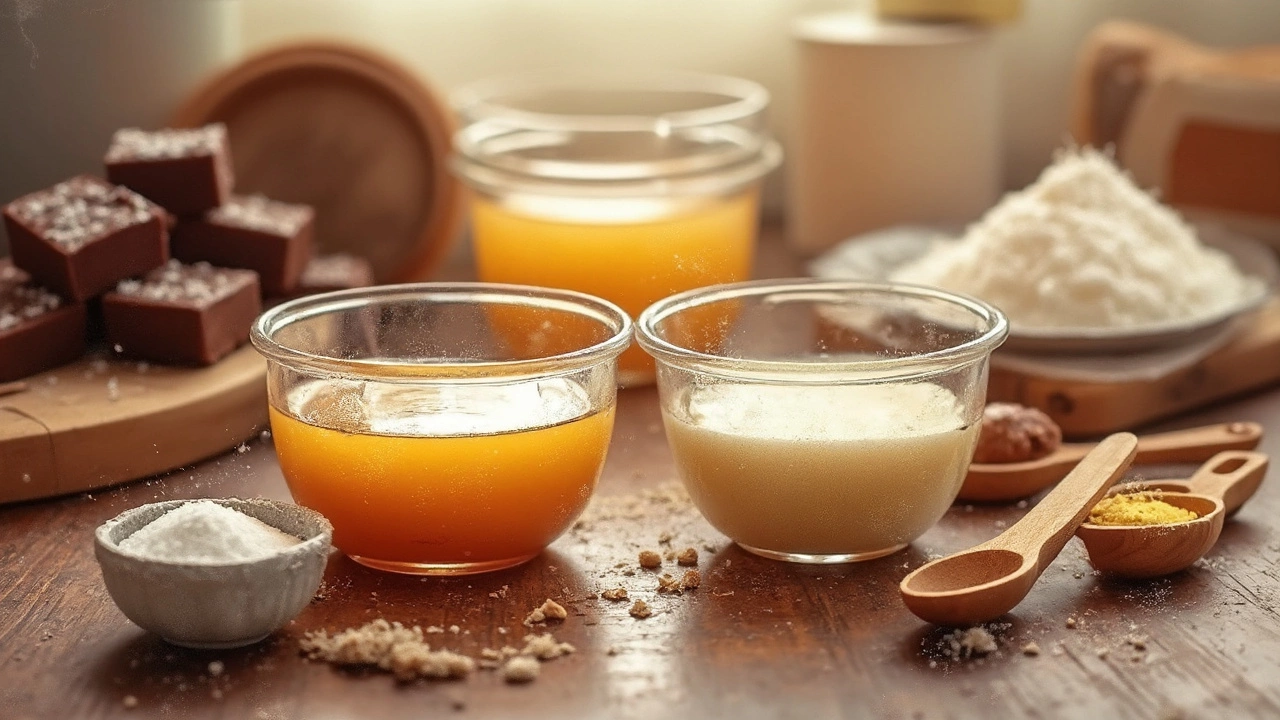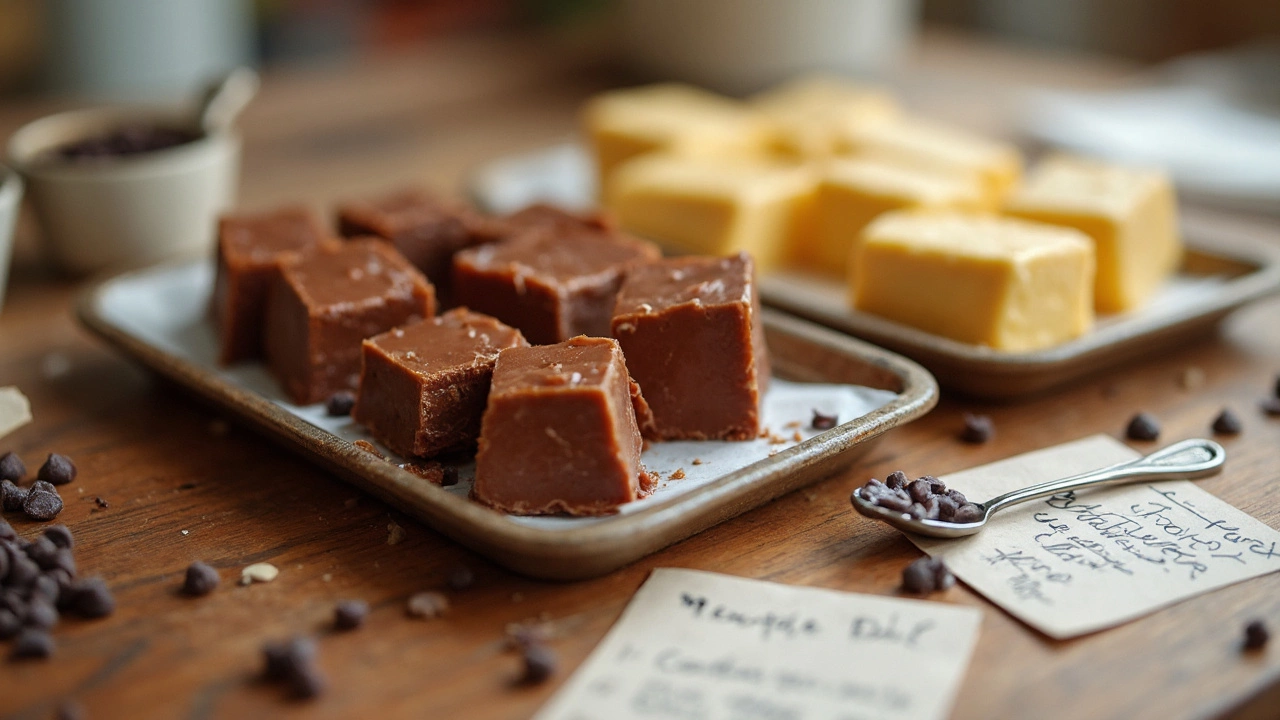
If you're standing in the kitchen with a fudge recipe in one hand and only a jar of honey in the pantry, you’re probably wondering if you can pull off a quick swap. Here’s the quick answer: you can, but expect some changes.
Condensed milk is thick, creamy, and brings sweetness plus a milky body to fudge. Honey is all about liquid sweetness, and it's not nearly as dense. If you pour honey straight in as a one-to-one sub, your fudge will end up gooey and never quite solid. But, with the right tweaks, you can use honey and still get a great treat—just different from the classic stuff.
This isn’t only about swapping sugar. Condensed milk’s milk solids and reduced water content give fudge its texture. Using honey will shift things, especially the structure and the flavor. Wonder how to balance it out? Keep going. I’ll break down the easiest ways to actually make this swap work (and how to avoid fudge fails along the way).
- What Makes Condensed Milk Essential?
- How Does Honey Stack Up?
- How to Substitute Honey for Condensed Milk
- Flavor and Texture: What to Expect
- Tips for Better Results with Honey
What Makes Condensed Milk Essential?
Ever wonder why condensed milk is in pretty much every classic fudge recipe? It isn’t just for sweetness. Condensed milk is cow’s milk with about 60% of the water removed, so it’s thick and sticky. Then, sugar is added, making it extra sweet and shelf-stable. These two things—the low water content and lots of sugar—are critical for getting that smooth, creamy fudge texture people love.
If you’ve tried other sweeteners and got fudge that wouldn’t set or turned out grainy, it’s because condensed milk brings structure. It holds everything together when you melt chocolate, butter, or whatever else you toss in. Think of it as the backbone of the whole dessert. Skipping it? You’ll need something else that can pull its weight, which isn’t easy since alternatives like honey or maple syrup are much runnier.
Here’s what makes condensed milk such a game-changer in fudge recipes:
- It’s thick—way thicker than regular milk or most liquid sweeteners. Fudge depends on that density to hold its shape.
- The high sugar content isn’t just for sweetness. It helps with the creamy, non-grainy texture, and plays a part in helping fudge set at room temperature.
- Its milk solids add that rich, almost caramelized flavor you expect from classic fudge.
According to USDA, sweetened condensed milk contains about 321 calories, 8 grams of fat, and a hefty 54 grams of sugar per 100 grams. It’s all about packing in flavor and smoothness. Swapping this out for something runnier, like honey, changes not just the taste but the way your fudge holds together—so you need to tweak your methods if you want anything close to that perfect square of fudge.
How Does Honey Stack Up?
Let’s compare honey side by side with condensed milk and see what swaps actually mean for your fudge. First, consistency. Condensed milk is thick, sticky, and way less runny than honey. That matters a lot for fudge, because fudge depends on getting the right set and chewiness.
If you measure by tablespoon, honey is about twice as runny as condensed milk. Its texture is syrupy, while condensed milk is closer to a pourable cream. If you use honey without any tweaks, your fudge will end up softer, maybe even spoon-able. Not so great for holding a bar shape.
Now let’s dig into the sweetness angle. Honey is a bit sweeter than condensed milk, but its sugars are mostly fructose and glucose, while condensed milk brings in lactose and normal cane sugar. This not only changes the flavor (honey adds floral or earthy notes) but it also changes how your fudge sets and how easily it crystalizes.
Here’s a quick breakdown to compare:
| Honey | Condensed Milk | |
|---|---|---|
| Sugar Type | Mainly Fructose, Glucose | Lactose, Sucrose |
| Texture | Sticky, runny | Thick, creamy |
| Sweetness per 100g | About 80g | About 55g |
| Water Content | About 20% | Less than 10% |
As baking expert Stella Parks once said,
"Condensed milk isn’t just about sweetness—the concentrated milk proteins and fats create the unique fudge texture. Substitutes have to make up for that or you won’t get the same results."
That’s why honey, while sweet and tasty, can’t do the same job on its own. You’ll need to adjust your recipe if you want fudge with the right structure, not just the right taste.
Using honey for fudge also means a change in taste. Every honey has its own notes, sometimes subtle, sometimes surprisingly strong. Your fudge will take on those flavors. Honey is also more hygroscopic, so it pulls in moisture, which means a chewier, sometimes sticky fudge. If you live in a humid place, this is double the trouble for homemade candy.
So, does honey work in place of condensed milk? Not as a straight swap, but it’s not impossible. If you’re up for tweaking, you can definitely make it happen—just expect fudge that’s a bit different from your grandma’s classic squares.

How to Substitute Honey for Condensed Milk
Making fudge with honey instead of condensed milk isn’t hard, but it’s not just a simple swap by measurement. To keep your fudge from turning into a sticky puddle, you need to change a few things. Condensed milk is thick—almost syrupy—because it has less water and plenty of milk solids. Honey is sweeter than condensed milk, but it’s much runnier. Here’s a practical way to make the switch without ruining your recipe.
- Cut Back on Other Liquids: Drop or reduce milk, cream, or water by at least half. Your fudge mixture will otherwise be too thin, and it won't set properly.
- Use Less Honey: Since honey is sweeter, use about 2/3 cup of honey for every 1 cup of condensed milk you’re replacing. This keeps your fudge from being overly sweet.
- Thicken with Milk Powder: Add 2-3 tablespoons of powdered milk to boost the creamy texture. If you don’t have powdered milk, nonfat dry milk will do the trick.
- Cook Longer: Simmer your fudge mix a bit longer to let extra water cook off. Stir often and keep an eye on the texture—it should get thicker as it cooks.
Here’s a handy comparison chart for the swap:
| Ingredient | Standard Fudge | Honey Sub |
|---|---|---|
| Condensed Milk | 1 cup | — |
| Honey | — | 2/3 cup |
| Milk Powder | — | 2-3 tbsp |
| Extra Liquid | 2-3 tbsp | None or as little as possible |
One last thing: honey is runny at room temp and only firms up a little when chilled. Expect your fudge to be softer and a bit sticky. If that bugs you, set your fudge in the fridge for a few hours; it’ll firm up more that way. For a touch of extra stability, a small pinch of cornstarch added with the powdered milk can also help.
Give it a try—even with the change in texture, the deep caramel buzz of honey gives your fudge a flavor twist you might really love!
Flavor and Texture: What to Expect
Swapping honey for condensed milk in fudge is going to change the results quite a bit. Condensed milk has a creamy, thick texture and a mild, milky sweetness. Honey, on the other hand, is thinner, stickier, and brings its own unique floral or earthy notes.
Right away, you’ll notice your fudge will be softer if you use honey, and sometimes it won’t set firmly at all. That’s because honey adds more liquid to your recipe, throwing off the moisture balance. Traditional fudge gets its structure from the milk solids and sugar concentration in condensed milk—honey lacks both. Expect a chewier, slightly sticky result instead of that classic creamy snap. Some people even describe honey fudge as having a taffy-like chew.
The sweetness level shifts, too. Honey is sweeter by weight, but its flavor can be stronger and more complex compared to the simple sugar taste of condensed milk. Also, the kind of honey you use matters. Clover honey is mild, but wildflower or buckwheat honey brings strong, sometimes overpowering flavor. And let’s be honest—a honey fudge is going to taste like honey no matter what you mix in.
| Ingredient | Texture | Sweetness | Flavor Impact |
|---|---|---|---|
| Condensed Milk | Creamy, holds shape | Medium, smooth | Mild, milky |
| Honey | Soft, sticky, chewy | High, more complex | Strong, floral/earthy |
So, if you want that classic fudge bite, honey won’t deliver a perfect clone. For folks who love a gooier, more flavorful candy, though, honey can be a fun twist. Just remember to lower the amount of other liquids (sometimes even skipping them) and maybe add a bit of dried milk or other thickener if you crave more body.
Finally, storage is different: honey fudge stays slightly sticky and is best kept chilled or it can get really soft, especially on hot days. Condensed milk fudge is way more forgiving at room temp. So, plan ahead if you’re thinking of gift baskets or summer parties!

Tips for Better Results with Honey
Substituting honey for condensed milk in fudge recipes calls for a little extra care. Here’s how you can get as close as possible to the rich, chewy fudge you love, even with the swap.
- Cut the liquid: Honey is thinner and runnier than condensed milk, which means you’ll want to reduce other liquids in your recipe (milk, water, or butter). If the original calls for extra milk or butter, cut back by at least half to help the fudge set.
- Use less honey: Because honey is sweeter than condensed milk, use 2/3 cup honey for each cup of condensed milk the recipe calls for. This keeps your fudge from being too sweet or gooey.
- Add a thickener: Honey won’t help your fudge set up firm. Add 2 to 3 tablespoons of powdered milk or even dry milk powder for each cup of honey. This adds back the milk solids and thickens things up.
- Watch the cook time: Fudge made with honey cooks and sets faster. Check early and, if you use a candy thermometer, aim for the soft-ball stage (234–240°F or about 112–115°C).
- Balance the flavor: Honey has a distinct, sometimes floral taste. Pick lighter honey for milder fudge, or darker honey for a stronger kick. Pair it with flavors that match—think peanut butter, nuts, or chocolate.
Here’s how the swap plays out by the numbers, so you don’t end up with a fudge brick or, worse, a fudgy puddle:
| Ingredient | Amount (Original) | Amount with Honey Swap |
|---|---|---|
| Condensed Milk | 1 cup | — |
| Honey | — | 2/3 cup |
| Powdered Milk | — | 2–3 tbsp |
| Other Liquids (milk, cream, butter) | As listed | Reduce by half |
One last thing: fudge with honey might stay softer, even after chilling. Store it in the fridge, and slice it just before serving. You might not get the classic texture, but you’ll end up with something uniquely tasty and a lot less processed.




